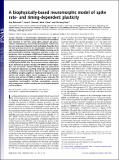A biophysically-based neuromorphic model of spike rate- and timing-dependent plasticity
Author(s)
Rachmuth, Guy; Shouval, Harel Z.; Bear, Mark; Poon, Chi-Sang
DownloadRachmuth-2011-A biophysically-base.pdf (1.559Mb)
PUBLISHER_POLICY
Publisher Policy
Article is made available in accordance with the publisher's policy and may be subject to US copyright law. Please refer to the publisher's site for terms of use.
Terms of use
Metadata
Show full item recordAbstract
Current advances in neuromorphic engineering have made it possible to emulate complex neuronal ion channel and intracellular ionic dynamics in real time using highly compact and power-efficient complementary metal-oxide-semiconductor (CMOS) analog very-large-scale-integrated circuit technology. Recently, there has been growing interest in the neuromorphic emulation of the spike-timing-dependent plasticity (STDP) Hebbian learning rule by phenomenological modeling using CMOS, memristor or other analog devices. Here, we propose a CMOS circuit implementation of a biophysically grounded neuromorphic (iono-neuromorphic) model of synaptic plasticity that is capable of capturing both the spike rate-dependent plasticity (SRDP, of the Bienenstock-Cooper-Munro or BCM type) and STDP rules. The iono-neuromorphic model reproduces bidirectional synaptic changes with NMDA receptor-dependent and intracellular calcium-mediated long-term potentiation or long-term depression assuming retrograde endocannabinoid signaling as a second coincidence detector. Changes in excitatory or inhibitory synaptic weights are registered and stored in a nonvolatile and compact digital format analogous to the discrete insertion and removal of AMPA or GABA receptor channels. The versatile Hebbian synapse device is applicable to a variety of neuroprosthesis, brain-machine interface, neurorobotics, neuromimetic computation, machine learning, and neural-inspired adaptive control problems.
Date issued
2011-11Department
Harvard University--MIT Division of Health Sciences and Technology; Massachusetts Institute of Technology. Department of Brain and Cognitive SciencesJournal
Proceedings of the National Academy of Sciences
Publisher
National Academy of Sciences
Citation
Rachmuth, G. et al. “PNAS Plus: A Biophysically-based Neuromorphic Model of Spike Rate- and Timing-dependent Plasticity.” Proceedings of the National Academy of Sciences 108.49 (2011): E1266–E1274.
Version: Final published version
ISSN
0027-8424
1091-6490